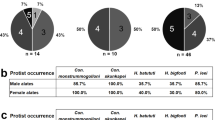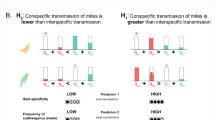Abstract.
Mutualistic associations between different organisms are theoretically expected when the interests of independently reproducing units are aligned to form a single reproductive unit. This alignment does not come about easily, because models show that hosts and symbionts can be in conflict over the transmission of symbionts. Selection will favour hosts that are able to limit genetic variation of symbionts, for example by enforcing uniparental vertical transmission, while symbionts will be selected to disperse independently of the host. A crucial factor determining the evolution and elaboration of symbiotic relationships is therefore who controls the transmission of symbionts. In the fungus-growing termites (Macrotermintinae) horizontal transmission seems to be the rule as the termites normally acquire their cultivated fungus (Termitomyces) from the environment. In spite of this general pattern, uniparental, vertical transmission has evolved in two unrelated Macrotermitinae genera, where only one sex of the two primary reproductives carries asexual spores from the fungal comb of its parent colony to inoculate the new fungus comb. Remarkably, symbiont transmission is exclusively paternal in Macrotermes bellicosus, whereas symbionts are maternally inherited in all Microtermes species studied so far. Thus, in Macrotermitinae horizontal transmission is the ancestral state with two independent origins to uniparental, vertical transmission. This is in contrast to fungus-growing ants where uniparental, vertical transmission is the rule. Causes and consequences of this difference are further discussed. Despite this fundamental difference both groups evolved a similar symbiosis that is probably the key for their ecological success: the fungus-growing ants in the neotropics and the fungus-growing termites in the paleotropics.
Similar content being viewed by others
Author information
Authors and Affiliations
Additional information
Electronic Publication
Rights and permissions
About this article
Cite this article
Korb, J., Aanen, D.K. The evolution of uniparental transmission of fungal symbionts in fungus-growing termites (Macrotermitinae). Behav Ecol Sociobiol 53, 65–71 (2003). https://doi.org/10.1007/s00265-002-0559-y
Received:
Revised:
Accepted:
Issue Date:
DOI: https://doi.org/10.1007/s00265-002-0559-y




